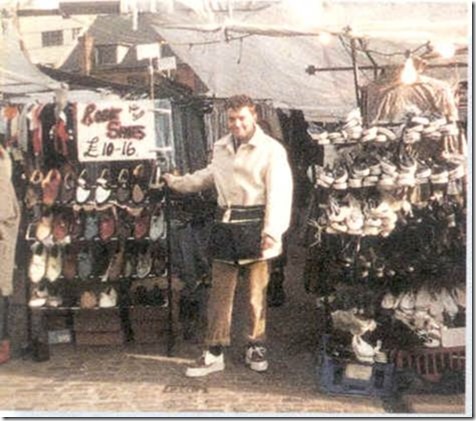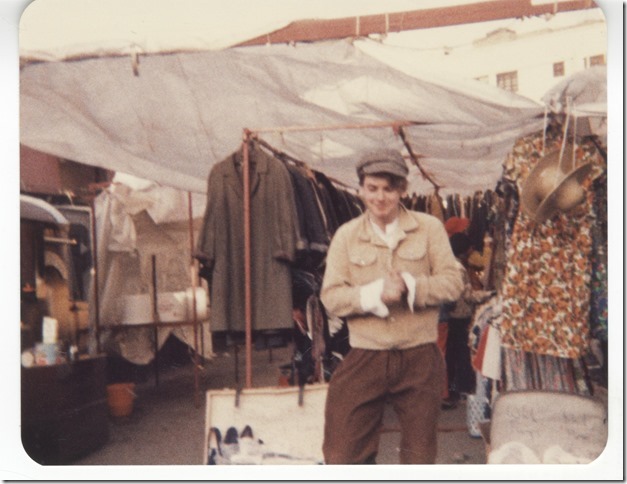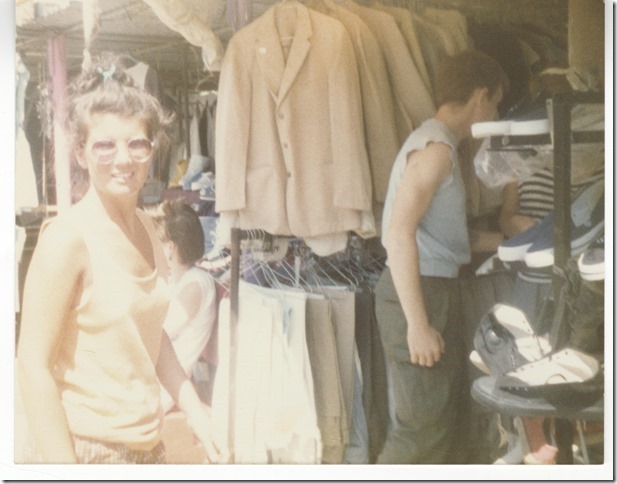It was the turn of the 80s and me and my wife Gerardine were new to London from Lancashire, just out of our teens. We were having fun – records, clothes, nightclubs – and we just fell into our business all thanks to a market. It showed us for the first time you could make money from fashion.
I had blown the rent on my band. To raise some more, we hired a stall at a new market in Camden, North West London, that I’d read about in Time Out. It just up from the Electric Ballroom and only £6 to rent a pitch, which wasn’t a lot of money even then. You didn’t have to be wealthy, or go to the bank with a business plan to get a loan. You could just have a go.
Gerardine sold some of the clothes she’d made for herself. I had always had a good eye for clothes and so I sold some of my second hand ones. On the Saturday we made £100. We came back the next day and took £180. Within a year we had 16 stalls and were selling second-hand clothing and footwear that we sourced from all over the country and abroad.
Then a few months later, we started up another in Kensington Market in West London. It was youth culture heaven, full of tattoo artists, hairdressers and people with sewing machines selling the clothes they were busy making. We were selling Gerardine’s designs, made with fabric she’d bought on Blackburn Market. They didn’t even have a label in them.
Within a month of her being there a buyer from Macy’s in New York came along to the market for a look round and liked Gerardine’s designs so much that she placed an order with us. Our business Red or Dead was born. Without Kensington Market, that Macy’s buyer would never have found us. She’d come to attend London Fashion Week at Olympia, but there was no way in 1982 that London Fashion Week was on our horizon.

Red or Dead grew into a worldwide brand, and we went on to do 21 consecutive seasons on the catwalk at London Fashion Week. We trace it all back to that first market stall. Gerardine and I can see how starting out in a market taught us very quickly so much that it might have taken years for us to learn at college. Some of the lessons were simple, such as get their early, so you can get the best pitch. Others become second nature.
We learnt what good design was, what was rubbish and by being on a stall and seeing the whites of customers’ eyes. If they said they’d leave it and come back later, we soon learnt whether the design could be improved. And there’s no better place than a market to learn how to sell. In your quiet moments, you get to chat to other stallholders, find out where they get their stock from, what works for their customers.
It is all very different from starting out on the internet as many designers do now. The internet is great, don’t get me wrong, but be multi-platform and experiment with a market stall as well. It gives you that opportunity for what you’ve made to be touched and felt by customers, for them to meet you and like you.
We carried on running our market stalls until 1990, adding other outlets at Afflecks Palace in Manchester, Quiggins in Liverpool and the Corn Exchange in Leeds, but eventually the expansion of Red or Dead was taking up too much of our energy. We let them go. Since then Kensington Market has become PC World and Camden today is very different. These things go in cycles.

In London, though, there are still some exciting, diverse markets, and Afflecks is still going strong in Manchester but outside the major cities and posh market towns, too often markets have become associated with selling broken biscuit assortments and mismatched slippers. They don’t need to be like that. It is like so many public events. There are good ones and bad ones.
What makes a good one is careful curatorship. So the reason Glastonbury is such a successful music festival is that they don’t just open up a stage and put anyone on it. They curate it so there is a narrative. And the same has to be true of a market. You can’t just let anybody set up. The local council, or whoever is in charge, has to know their onions and have a clear idea about who they want to attract and what balance of products they are aiming to achieve.
There are changes afoot today that are encouraging that return to markets. Take the growing interest in artisan or organically produced food. That is prompting the rise of farmers’ markets. There is plenty to build on. In the end the attraction of a market is human interaction. People like to get together. There is only so much solitude, sitting at our computer screens, which most of us can take. Historically town centres offered us that chance. It was in many ways what they were designed for – a big coming together. We may go for shopping, or we may just go to look, eye people up, judge them even. That is never going to change. You can’t do it virtually.
A well-curated market can be at the very heart of that human getting together. I do a lot of work now at London’s Southbank Centre I remember it, from the late 70s , as a desolate place, but now it has been transformed into an all year round vibrant and really successful public place, a very modern “marketplace” where people come together to eat, drink, take in the arts, culture, views. Part of that is down to real generosity – there’s free Wi-Fi, and you can take your packed lunch and eat it in the Royal Festival Hall. There’s also a brilliantly curated and diverse arts and entertainment programme and there are market stalls, selling one-offs. Outside of the food retailers there’s barely any traditional retail at all. The location next to the River Thames helps, of course, but it does show that you don’t need a Topshop or chain store to pull people in to a market.

Thinking back, Gerardine and I were lucky. It isn’t as easy to get going from a market stall any more. By 1990, when we left, we were paying around £100 at Camden for our stalls. Today I’m told their equivalent would cost £1760. But there are still places where a market stall is a cost-effective way of getting what you are making in front of people. Give it a go. We did and look what happened.
Click here to read the published article in The Telegraph.